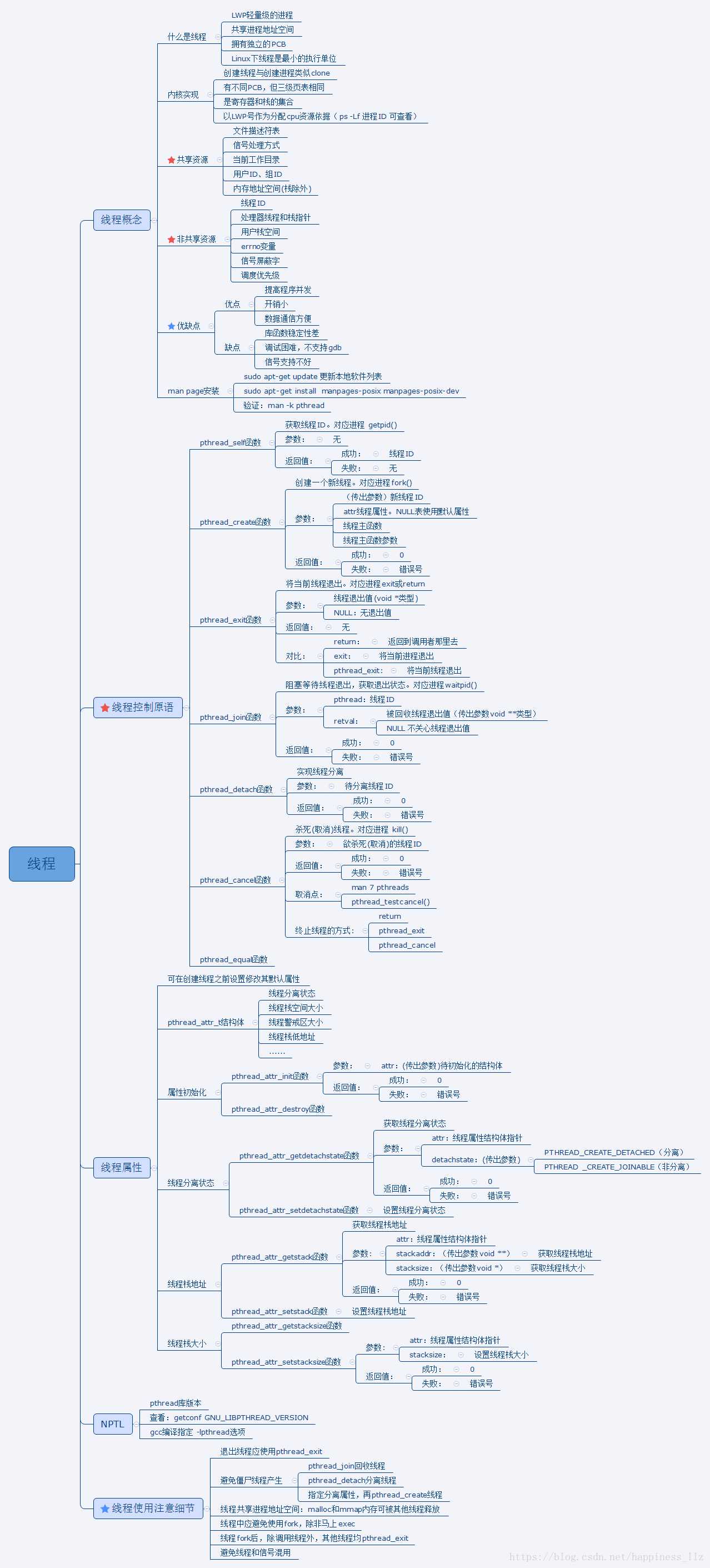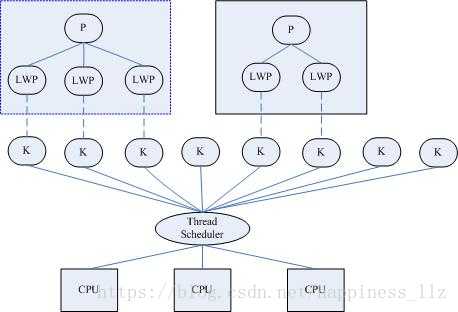标签:sch 申请 class splay 2.7 操作 简单 缺省值 string
一、整体大纲

二、线程相关
1. 什么是线程

LWP:light weight process 轻量级的进程,本质仍是进程(在Linux环境下)
进程:独立地址空间,拥有PCB
线程:也有PCB,但没有独立的地址空间(共享)
区别:在于是否共享地址空间。 独居(进程);合租(线程)。
Linux下: 线程:最小的执行单位
进程:最小分配资源单位,可看成是只有一个线程的进程。
2. Linux内核线程实现原理
(1)线程实现原理
类Unix系统中,早期是没有“线程”概念的,80年代才引入,借助进程机制实现出了线程的概念。因此在这类系统中,进程和线程关系密切。
1)轻量级进程(light-weight process),也有PCB,创建线程使用的底层函数和进程一样,都是clone
2)从内核里看进程和线程是一样的,都有各自不同的PCB,但是PCB中指向内存资源的三级页表是相同的
3)进程可以蜕变成线程
4)线程可看做寄存器和栈的集合
5)在linux下,线程最是小的执行单位;进程是最小的分配资源单位
察看LWP号:ps -Lf pid 查看指定线程的lwp号。
三级映射:进程PCB --> 页目录(可看成数组,首地址位于PCB中) --> 页表 --> 物理页面 --> 内存单元
参考:《Linux内核源代码情景分析》 ----毛德操
对于进程来说,相同的地址(同一个虚拟地址)在不同的进程中,反复使用而不冲突。原因是他们虽虚拟址一样,但,页目录、页表、物理页面各不相同。相同的虚拟址,映射到不同的物理页面内存单元,最终访问不同的物理页面。
但!线程不同!两个线程具有各自独立的PCB,但共享同一个页目录,也就共享同一个页表和物理页面。所以两个PCB共享一个地址空间。
实际上,无论是创建进程的fork,还是创建线程的pthread_create,底层实现都是调用同一个内核函数clone。
如果复制对方的地址空间,那么就产出一个“进程”;如果共享对方的地址空间,就产生一个“线程”。
因此:Linux内核是不区分进程和线程的。只在用户层面上进行区分。所以,线程所有操作函数 pthread_* 是库函数,而非系统调用。
(2)线程共享资源
1)文件描述符表
2)每种信号的处理方式
3)当前工作目录
4)用户ID和组ID
5)内存地址空间 (.text/.data/.bss/heap/共享库)
(3)线程非共享资源
1)线程id
2)处理器现场和栈指针(内核栈)
3)独立的栈空间(用户空间栈)
4)errno变量
5)信号屏蔽字
6)调度优先级
(4)线程优、缺点
优点:
1)提高程序并发性
2)开销小
3)数据通信、共享数据方便
缺点:
1)库函数,不稳定
2)调试、编写困难、gdb不支持
3)对信号支持不好
优点相对突出,缺点均不是硬伤。Linux下由于实现方法导致进程、线程差别不是很大。
3. 线程控制相关函数
(1)pthread_self函数
获取线程ID。其作用对应进程中 getpid() 函数。
pthread_t pthread_self(void); 返回值:成功:0; 失败:无
线程ID:pthread_t类型,本质:在Linux下为无符号整数(%lu),其他系统中可能是结构体实现
线程ID是进程内部,识别标志。(两个进程间,线程ID允许相同)
注意:不应使用全局变量 pthread_t tid,在子线程中通过pthread_create传出参数来获取线程ID,而应使用pthread_self。
(2)pthread_create函数
创建一个新线程。 其作用,对应进程中fork() 函数。
int pthread_create(pthread_t *thread, const pthread_attr_t *attr, void *(*start_routine) (void *), void *arg);
返回值:成功:0; 失败:错误号 -----Linux环境下,所有线程特点,失败均直接返回错误号。
参数:
thread 线程的id,传出参数,pthread_t:当前Linux中可理解为:typedef unsigned long int pthread_t;
attr 代表线程的属性,通常传NULL,表示使用线程默认属性。若想使用具体属性也可以修改该参数。
第三个参数函数指针 void *func(void *),指向线程主函数(线程体),该函数运行结束,则线程结束。
arg 线程主函数执行期间所使用的参数。
返回值:
成功返回0
失败返回errno
注意:编译的时候需要加pthread库(Compile and link with -pthread.)
在一个线程中调用pthread_create()创建新的线程后,当前线程从pthread_create()返回继续往下执行,而新的线程所执行的代码由我们传给pthread_create的函数指针start_routine决定。
start_routine函数接收一个参数,是通过pthread_create的arg参数传递给它的,该参数的类型为void *,这个指针按什么类型解释由调用者自己定义。start_routine的返回值类型也是void *,这个指针
的含义同样由调用者自己定义。start_routine返回时,这个线程就退出了,其它线程可以调用pthread_join得到start_routine的返回值,类似于父进程调用wait(2)得到子进程的退出状态,稍后详细介绍pthread_join。
pthread_create成功返回后,新创建的线程的id被填写到thread参数所指向的内存单元。我们知道进程id的类型是pid_t,每个进程的id在整个系统中是唯一的,调用getpid(2)可以获得当前进程的
id,是一个正整数值。线程id的类型是thread_t,它只在当前进程中保证是唯一的,在不同的系统中thread_t这个类型有不同的实现,它可能是一个整数值,也可能是一个结构体,也可能是一个地
址,所以不能简单地当成整数用printf打印,调用pthread_self(3)可以获得当前线程的id。
attr参数表示线程属性,本节不深入讨论线程属性,所有代码例子都传NULL给attr参数,表示线程属性取缺省值,感兴趣的读者可以参考APUE。
练习:创建一个新线程,打印线程ID。注意:链接线程库 -lpthread

1 #include <stdio.h> 2 #include <unistd.h> 3 #include <pthread.h> 4 5 void *thr(void *arg) 6 { 7 printf("I am a thread! pid = %d, tid = %lu\n", getpid(), pthread_self()); 8 return NULL; 9 } 10 11 int main() 12 { 13 pthread_t tid; 14 pthread_create(&tid, NULL, thr, NULL); 15 printf("I am main thread, pid = %d, tid = %lu\n", getpid(), pthread_self()); 16 sleep(1); 17 18 return 0; 19 }
由于pthread_create的错误码不保存在errno中,因此不能直接用perror(3)打印错误信息,可以先用strerror(3)把错误码转换成错误信息再打印。如果任意一个线程调用了exit或_exit,则整个进程的所有线程都终止,由于从main函数return也相当于调用exit,为了防止新创建的线程还没有得到执行就终止,我们在main函数return之前延时1秒,这只是一种权宜之计,即使主线程等待1秒,内核也不一定会调度新创建的线程执行,下一节我们会看到更好的办法。
练习:循环创建多个线程,每个线程打印自己是第几个被创建的线程。(类似于进程循环创建子进程)

1 #include <stdio.h> 2 #include <unistd.h> 3 #include <pthread.h> 4 #include <stdlib.h> 5 #include <string.h> 6 7 void *thr(void *arg) 8 { 9 int num = (int)arg; 10 printf("I am %d thread, self = %lu\n", num, pthread_self()); 11 12 return (void *)(100 + num); 13 } 14 15 int main() 16 { 17 pthread_t tid[5]; 18 int i = 0; 19 for (i = 0; i < 5; i++) 20 { 21 pthread_create(&tid[i], NULL, thr, (void*)i); 22 } 23 24 for (i = 0; i < 5; i++) 25 { 26 void *ret; 27 pthread_join(tid[i], &ret); 28 printf("i = %d, ret = %d\n", i, (int)ret); 29 } 30 31 return 0; 32 }
拓展思考:将pthread_create函数参4修改为(void *)&i, 将线程主函数内改为 i=*((int *)arg) 是否可以?
线程与共享
线程间共享全局变量!
注意:线程默认共享数据段、代码段等地址空间,常用的是全局变量。而进程不共享全局变量,只能借助mmap。
练习:设计程序,验证线程之间共享全局数据。

1 #include <stdio.h> 2 #include <unistd.h> 3 #include <pthread.h> 4 #include <stdlib.h> 5 #include <string.h> 6 7 int var = 100; 8 9 void *thr(void *arg) 10 { 11 printf("I am a thread, self = %lui, var = %d\n", pthread_self(), var); 12 sleep(2); 13 var = 101; 14 printf("I am a thread, self = %lu, var = %d\n", pthread_self(), var); 15 16 return NULL; 17 } 18 19 int main() 20 { 21 pthread_t tid; 22 pthread_create(&tid, NULL, thr, NULL); 23 printf("I am main thread, pid = %d, tid = %lu\n", getpid(), pthread_self()); 24 25 pthread_detach(tid); //线程分离 26 printf("I am main thread, self = %lui, var = %d\n", pthread_self(), var); 27 var = 1003; 28 sleep(5); 29 printf("I am main thread, self = %lui, var = %d\n", pthread_self(), var); 30 31 return 0; 32 }
(3)pthread_exit函数
将单个线程退出
void pthread_exit(void *retval); 参数:retval表示线程退出状态,通常传NULL
思考:使用exit将指定线程退出,可以吗?
结论:线程中,禁止使用exit函数,会导致进程内所有线程全部退出。
在不添加sleep控制输出顺序的情况下。pthread_create在循环中,几乎瞬间创建5个线程,但只有第1个线程有机会输出(或者第2个也有,也可能没有,取决于内核调度)如果第3个线程执行了
exit,将整个进程退出了,所以全部线程退出了。
所以,多线程环境中,应尽量少用,或者不使用exit函数,取而代之使用pthread_exit函数,将单个线程退出。任何线程里exit导致进程退出,其他线程未工作结束,主控线程退出时不能return或exit。
另注意,pthread_exit或者return返回的指针所指向的内存单元必须是全局的或者是用malloc分配的,不能在线程函数的栈上分配,因为当其它线程得到这个返回指针时线程函数已经退出了。
练习:编写多线程程序,总结exit、return、pthread_exit各自退出效果。

1 #include <stdio.h> 2 #include <unistd.h> 3 #include <pthread.h> 4 #include <stdlib.h> 5 6 void *thr(void *arg) 7 { 8 printf("I am a thread! pid = %d, tid = %lu\n", getpid(), pthread_self()); 9 //return NULL; 10 pthread_exit(NULL); 11 //exit(1); 12 } 13 14 int main() 15 { 16 pthread_t tid; 17 pthread_create(&tid, NULL, thr, NULL); 18 printf("I am main thread, pid = %d, tid = %lu\n", getpid(), pthread_self()); 19 20 sleep(10); 21 printf("I will out.\n"); 22 23 pthread_exit(NULL); 24 25 return 0; 26 }
(4)pthread_join函数
阻塞等待线程退出,获取线程退出状态 其作用,对应进程中 waitpid() 函数。
int pthread_join(pthread_t thread, void **retval); 成功:0;失败:错误号
参数:
thread:线程ID (注意:不是指针)
retval:存储线程结束状态
对比记忆:
进程中:main返回值、exit参数-->int;等待子进程结束 wait 函数参数-->int *
线程中:线程主函数返回值、pthread_exit-->void *;等待线程结束 pthread_join 函数参数-->void **
练习:参数 retval 非空用法。

1 #include <stdio.h> 2 #include <unistd.h> 3 #include <pthread.h> 4 #include <stdlib.h> 5 6 void *thr(void *arg) 7 { 8 printf("I am a thread! pid = %d, tid = %lu\n", getpid(), pthread_self()); 9 //return (void*)100; //这样退出线程也可以 10 pthread_exit((void *)100); 11 } 12 13 int main() 14 { 15 pthread_t tid; 16 pthread_create(&tid, NULL, thr, NULL); 17 printf("I am main thread, pid = %d, tid = %lu\n", getpid(), pthread_self()); 18 19 void *ret = NULL; 20 pthread_join(tid, &ret); //阻塞等待 21 22 printf("ret exit with %d\n", (int)ret); 23 24 pthread_exit(NULL); 25 26 return 0; 27 }
调用该函数的线程将挂起等待,直到id为thread的线程终止。thread线程以不同的方法终止,通过pthread_join得到的终止状态是不同的,总结如下:
练习:使用pthread_join函数将循环创建的多个子线程回收。

1 #include <stdio.h> 2 #include <unistd.h> 3 #include <pthread.h> 4 #include <stdlib.h> 5 #include <string.h> 6 7 void *thr(void *arg) 8 { 9 int num = (int)arg; 10 printf("I am %d thread, self = %lu\n", num, pthread_self()); 11 12 return (void *)(100 + num); 13 } 14 15 int main() 16 { 17 pthread_t tid[5]; 18 int i = 0; 19 for (i = 0; i < 5; i++) 20 { 21 pthread_create(&tid[i], NULL, thr, (void*)i); 22 } 23 24 for (i = 0; i < 5; i++) 25 { 26 void *ret; 27 pthread_join(tid[i], &ret); 28 printf("i = %d, ret = %d\n", i, (int)ret); 29 } 30 31 return 0; 32 }
(5)pthread_detach函数
实现线程分离
int pthread_detach(pthread_t thread); 成功:0;失败:错误号
线程分离状态:指定该状态,线程主动与主控线程断开关系。线程结束后,其退出状态不由其他线程获取,而直接自己自动释放。网络、多线程服务器常用。
进程若有该机制,将不会产生僵尸进程。僵尸进程的产生主要由于进程死后,大部分资源被释放,一点残留资源仍存于系统中,导致内核认为该进程仍存在。
也可使用 pthread_create函数参2(线程属性)来设置线程分离。
练习:使用pthread_detach函数实现线程分离 。

1 #include <stdio.h> 2 #include <unistd.h> 3 #include <pthread.h> 4 #include <stdlib.h> 5 #include <string.h> 6 7 void *thr(void *arg) 8 { 9 printf("I am a thread, self = %lu\n", pthread_self()); 10 sleep(4); 11 printf("I am a thread, self = %lu\n", pthread_self()); 12 13 return NULL; 14 } 15 16 int main() 17 { 18 pthread_t tid; 19 pthread_create(&tid, NULL, thr, NULL); 20 printf("I am main thread, pid = %d, tid = %lu\n", getpid(), pthread_self()); 21 22 pthread_detach(tid); //线程分离 23 24 sleep(5); 25 26 //设置线程分离,如果再使用pthread_join回收线程会报错 27 /* 28 int ret = 0; 29 if ((ret = pthread_join(tid, NULL)) > 0) //阻塞等待 30 { 31 printf("join err: %d, %s\n", ret, strerror(ret)); 32 }*/ 33 34 return 0; 35 }
一般情况下,线程终止后,其终止状态一直保留到其它线程调用pthread_join获取它的状态为止。但是线程也可以被置为detach状态,这样的线程一旦终止就立刻回收它占用的所有资源,而不保留
终止状态。不能对一个已经处于detach状态的线程调用pthread_join,这样的调用将返回EINVAL错误。也就是说,如果已经对一个线程调用了pthread_detach就不能再调用pthread_join了。
(6)pthread_cancel函数
杀死(取消)线程 其作用,对应进程中 kill() 函数。
int pthread_cancel(pthread_t thread); 成功:0;失败:错误号
注意:线程的取消并不是实时的,而有一定的延时。需要等待线程到达某个取消点(检查点)。
类似于玩游戏存档,必须到达指定的场所(存档点,如:客栈、仓库、城里等)才能存储进度。杀死线程也不是立刻就能完成,必须要到达取消点。
取消点:是线程检查是否被取消,并按请求进行动作的一个位置。通常是一些系统调用creat,open,pause,close,read,write..... 执行命令man 7 pthreads可以查看具备这些取消点的系统调用列
表。也可参阅 APUE.12.7 取消选项小节。
可粗略认为一个系统调用(进入内核)即为一个取消点。如线程中没有取消点,可以通过调用pthreestcancel函数自行设置一个取消点。
被取消的线程, 退出值定义在Linux的pthread库中。常数PTHREAD_CANCELED的值是-1。可在头文件pthread.h中找到它的定义:#define PTHREAD_CANCELED ((void *) -1)。因此当我们对一
个已经被取消的线程使用pthread_join回收时,得到的返回值为-1。
练习:终止线程的三种方法。注意“取消点”的概念。

1 #include <stdio.h> 2 #include <unistd.h> 3 #include <pthread.h> 4 #include <stdlib.h> 5 6 void *thr(void *arg) 7 { 8 while(1) 9 { 10 //注意:如果没有下面这两行代码,也就是只是一个while(1)死循环,则无法杀死该线程 11 //或者加上pthread_testcancel();设置杀死点,函数也可以被主线程杀死 12 printf("I am a thread! pid = %d, tid = %lu\n", getpid(), pthread_self()); 13 sleep(1); 14 //pthread_testcancel(); 15 } 16 17 return NULL; 18 } 19 20 int main() 21 { 22 pthread_t tid; 23 pthread_create(&tid, NULL, thr, NULL); 24 printf("I am main thread, pid = %d, tid = %lu\n", getpid(), pthread_self()); 25 26 sleep(5); 27 pthread_cancel(tid); //杀死线程 28 29 void *ret; 30 pthread_join(tid, &ret); //阻塞等待 31 printf("thread exit with %d\n", (int)ret); 32 33 return 0; 34 }
终止线程方式:
总结:终止某个线程而不终止整个进程,有三种方法:
(7)pthread_equal函数
比较两个线程ID是否相等。
int pthread_equal(pthread_t t1, pthread_t t2);
有可能Linux在未来线程ID pthread_t 类型被修改为结构体实现。
4. 控制原语对比
进程 线程
fork pthread_create
exit pthread_exit
wait pthread_join
kill pthread_cancel
getpid pthread_self
5. 线程属性
本节作为指引性介绍,linux下线程的属性是可以根据实际项目需要,进行设置,之前我们讨论的线程都是采用线程的默认属性,默认属性已经可以解决绝大多数开发时遇到的问题。如我们对程序的性能提出更高的要求那么需要设置线程属性,比如可以通过设置线程栈的大小来降低内存的使用,增加最大线程个数。
typedef struct { int etachstate; //线程的分离状态 int schedpolicy; //线程调度策略 struct sched_param schedparam; //线程的调度参数 int inheritsched; //线程的继承性 int scope; //线程的作用域 size_t guardsize; //线程栈末尾的警戒缓冲区大小 int stackaddr_set; //线程的栈设置 void* stackaddr; //线程栈的位置 size_t stacksize; //线程栈的大小 } pthread_attr_t;
主要结构体成员:
属性值不能直接设置,须使用相关函数进行操作,初始化的函数为pthread_attr_init,这个函数必须在pthread_create函数之前调用。之后须用pthread_attr_destroy函数来释放资源。
线程属性主要包括如下属性:作用域(scope)、栈尺寸(stack size)、栈地址(stack address)、优先级(priority)、分离的状态(detached state)、调度策略和参数(scheduling policy and
parameters)。默认的属性为非绑定、非分离、缺省的堆栈、与父进程同样级别的优先级。
1)线程属性初始化
注意:应先初始化线程属性,再pthread_create创建线程
初始化线程属性
int pthread_attr_init(pthread_attr_t *attr); 成功:0;失败:错误号
销毁线程属性所占用的资源
int pthread_attr_destroy(pthread_attr_t *attr); 成功:0;失败:错误号
2)线程的分离状态
线程的分离状态决定一个线程以什么样的方式来终止自己。
非分离状态:线程的默认属性是非分离状态,这种情况下,原有的线程等待创建的线程结束。只有当pthread_join()函数返回时,创建的线程才算终止,才能释放自己占用的系统资源。
分离状态:分离线程没有被其他的线程所等待,自己运行结束了,线程也就终止了,马上释放系统资源。应该根据自己的需要,选择适当的分离状态。
线程分离状态的函数:
设置线程属性,分离or非分离
int pthread_attr_setdetachstate(pthread_attr_t *attr, int detachstate);
获取程属性,分离or非分离
int pthread_attr_getdetachstate(pthread_attr_t *attr, int *detachstate);
参数:
attr:已初始化的线程属性
detachstate: PTHREAD_CREATE_DETACHED(分离线程)
PTHREAD _CREATE_JOINABLE(非分离线程)
这里要注意的一点是,如果设置一个线程为分离线程,而这个线程运行又非常快,它很可能在pthread_create函数返回之前就终止了,它终止以后就可能将线程号和系统资源移交给其他的线程使
用,这样调用pthread_create的线程就得到了错误的线程号。要避免这种情况可以采取一定的同步措施,最简单的方法之一是可以在被创建的线程里调用pthread_cond_timedwait函数,让这个线程等
待一会儿,留出足够的时间让函数pthread_create返回。设置一段等待时间,是在多线程编程里常用的方法。但是注意不要使用诸如wait()之类的函数,它们是使整个进程睡眠,并不能解决线程同步
的问题。
3)线程的栈地址
POSIX.1定义了两个常量_POSIX_THREAD_ATTR_STACKADDR 和_POSIX_THREAD_ATTR_STACKSIZE检测系统是否支持栈属性。也可以给sysconf函数传递_SC_THREAD_ATTR_STACKADDR或 _SC_THREAD_ATTR_STACKSIZE来进行检测。
当进程栈地址空间不够用时,指定新建线程使用由malloc分配的空间作为自己的栈空间。通过pthread_attr_setstack和pthread_attr_getstack两个函数分别设置和获取线程的栈地址。
int pthread_attr_setstack(pthread_attr_t *attr, void *stackaddr, size_t stacksize); 成功:0;失败:错误号 int pthread_attr_getstack(pthread_attr_t *attr, void **stackaddr, size_t *stacksize); 成功:0;失败:错误号
参数:
attr:指向一个线程属性的指针
stackaddr:返回获取的栈地址
stacksize:返回获取的栈大小
4)线程的栈大小
当系统中有很多线程时,可能需要减小每个线程栈的默认大小,防止进程的地址空间不够用,当线程调用的函数会分配很大的局部变量或者函数调用层次很深时,可能需要增大线程栈的默认大小。
函数pthread_attr_getstacksize和 pthread_attr_setstacksize提供设置。
int pthread_attr_setstacksize(pthread_attr_t *attr, size_t stacksize); 成功:0;失败:错误号 int pthread_attr_getstacksize(pthread_attr_t *attr, size_t *stacksize); 成功:0;失败:错误号
参数:
attr:指向一个线程属性的指针
stacksize:返回线程的堆栈大小
5)线程属性控制示例

1 #include <stdio.h> 2 #include <unistd.h> 3 #include <pthread.h> 4 #include <stdlib.h> 5 #include <string.h> 6 7 void *thr(void *arg) 8 { 9 printf("I am a thread\n"); 10 return NULL; 11 } 12 13 int main() 14 { 15 pthread_attr_t attr; 16 pthread_attr_init(&attr); 17 18 pthread_t tid; 19 pthread_create(&tid, &attr, thr, NULL); 20 21 int ret; 22 if ((ret = pthread_join(tid, NULL)) > 0) 23 { 24 printf("join err: %d, %s\n", ret, strerror(ret)); 25 return -1; 26 } 27 pthread_attr_destroy(&attr); //摧毁属性 28 29 return 0; 30 }

1 #include <stdio.h> 2 #include <unistd.h> 3 #include <pthread.h> 4 #include <stdlib.h> 5 #include <string.h> 6 7 void *thr(void *arg) 8 { 9 printf("I am a thread\n"); 10 return NULL; 11 } 12 13 int main() 14 { 15 pthread_attr_t attr; 16 pthread_attr_init(&attr); 17 18 //设置属性分离,不需要通过pthread_join回收 19 pthread_attr_setdetachstate(&attr, PTHREAD_CREATE_DETACHED); 20 21 pthread_t tid; 22 pthread_create(&tid, &attr, thr, NULL); 23 24 /* 25 int ret; 26 if ((ret = pthread_join(tid, NULL)) > 0) 27 { 28 printf("join err: %d, %s\n", ret, strerror(ret)); 29 return -1; 30 }*/ 31 pthread_attr_destroy(&attr); //摧毁属性 32 33 sleep(1); 34 35 return 0; 36 }

1 #include <pthread.h> 2 3 #define SIZE 0x100000 4 5 void *th_fun(void *arg) 6 { 7 while(1) 8 { 9 sleep(1); 10 } 11 } 12 13 int main(void) 14 { 15 pthread_t tid; 16 int err, detachstate, i = 1; 17 pthread_attr_t attr; 18 void *stackaddr; 19 size_t stacksize; 20 21 pthread_attr_init(&attr); 22 pthread_attr_getstack(&attr, &stackaddr, &stacksize); 23 pthread_attr_getdetachstate(&attr, &detachstate); 24 25 if (detachstate == PTHREAD_CREATE_DETACHED) 26 { 27 printf("thread detached\n"); 28 } 29 else if (detachstate == PTHREAD_CREATE_JOINABLE) 30 { 31 printf("thread join\n"); 32 } 33 else 34 { 35 printf("thread unknown\n"); 36 } 37 38 pthread_attr_setdetachstate(&attr, PTHREAD_CREATE_DETACHED); 39 40 while (1) 41 { 42 43 stackaddr = malloc(SIZE); 44 if (stackaddr == NULL) 45 { 46 perror("malloc"); 47 exit(1); 48 } 49 50 stacksize = SIZE; 51 pthread_attr_setstack(&attr, stackaddr, stacksize); 52 err = pthread_create(&tid, &attr, th_fun, NULL); 53 if (err != 0) 54 { 55 printf("%s\n", strerror(err)); 56 exit(1); 57 } 58 printf("%d\n", i++); 59 } 60 61 pthread_attr_destroy(&attr); 62 63 return 0; 64 }
6)NPTL
6. 线程使用注意事项
主线程退出其他线程不退出,主线程应调用pthread_exit
避免僵尸线程
被join线程可能在join函数返回前就释放完自己的所有内存资源,所以不应当返回被回收线程栈中的值;
malloc和mmap申请的内存可以被其他线程释放。
应避免在多线程模型中调用fork除非,马上exec,子进程中只有调用fork的线程存在,其他线程在子进程中均pthread_exit。
信号的复杂语义很难和多线程共存,应避免在多线程引入信号机制。
练习:
1. 实现一个守护进程,每分钟吸入一次日志,要去日志保存在$HOME/log/下,
2. 实现多线程拷贝。(利用mmap映射区)
标签:sch 申请 class splay 2.7 操作 简单 缺省值 string
原文地址:https://www.cnblogs.com/xuejiale/p/10817045.html